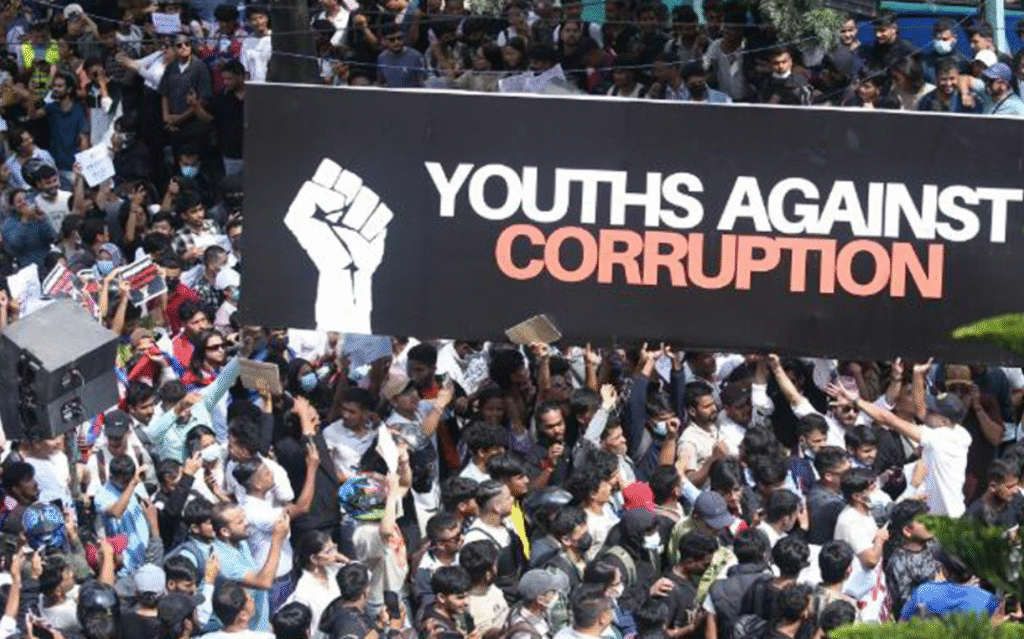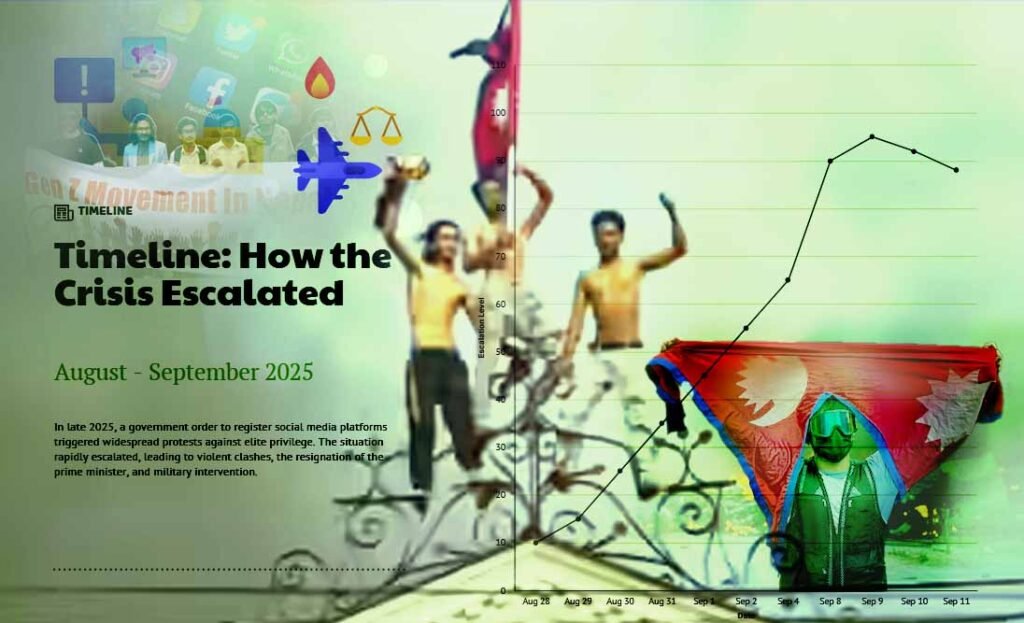From Social-Media Blackout to a Political Meltdown
A sweeping ban on Facebook, Instagram, YouTube, X, and 22 other platforms triggered Nepal’s largest youth-led protests in modern history. Within days, at least 19 people were killed, more than 300 injured, parliament was torched, and the prime minister was forced to resign. Soldiers patrolled empty streets under curfew. At the heart of the revolt was not just internet freedom but a generational rebellion against corruption, inequality, and an insulated political elite.
The Day the Internet Went Dark
On 26 August 2025, Nepal’s Ministry of Communication, Information and Broadcasting issued a late-night order that stunned the nation: 26 social-media platforms were blocked with immediate effect.

The government argued that global tech firms had failed to register under new national regulations, which required them to open liaison offices in Nepal, store user data domestically, and comply with content moderation laws.
The shutdown swept across Facebook, Instagram, YouTube, WhatsApp, X (formerly Twitter), LinkedIn, Reddit, Pinterest, and Signal. Overnight, millions of young Nepalis lost access to the platforms that shaped their social lives, businesses, and activism.
Why Was TikTok Not Banned?
One platform, however, stood out for its survival: TikTok remained accessible.
TikTok was the only major social-media platform that remained accessible in Nepal during the 2025 blackout, and that distinction shaped the uprising in crucial ways. Unlike Meta’s Facebook and Instagram, or Elon Musk’s X, TikTok had complied early with the government’s new rules — registering locally, opening a liaison office, and agreeing to content regulations. As a result, when 26 other platforms were taken down, TikTok stayed online and quickly became the de facto rallying point for Gen Z. Protesters used it not only to vent anger and share protest art but also to broadcast live from rallies, document police crackdowns, and circulate slogans such as “Shut down corruption, not social media.” In effect, TikTok transformed from an entertainment app into the last digital square — the one space where a generation could still gather, organise, and amplify its voice while the rest of the social-media ecosystem went dark.
This fact was not lost on the public. A year earlier, in November 2023, Nepal had briefly banned TikTok for “disrupting social harmony.” But after months of negotiations and promises of compliance — including pledges to uphold Nepal’s ban on pornographic content — the government lifted restrictions in August 2024. By 2025, TikTok was ironically the only platform legally active, while its American rivals went dark.
“Shut Down Corruption, Not Social Media”
The ban landed in a political climate already thick with discontent. For months, young Nepalis had been venting online about the privileges of “nepo kids” — the sons and daughters of party leaders flaunting imported cars, foreign vacations, and designer fashion.

By contrast, ordinary youth faced high unemployment, inflation, and the harsh reality of migrating abroad for low-paying work.
When the blackout hit, anger turned to outrage. Protest slogans captured the mood:
- “Shut down corruption, not social media.”
- “Youths against corruption.”
- “Our voices cannot be banned.”
The government had framed the ban as a matter of regulation and sovereignty. But for Gen Z, it became the symbol of a larger betrayal — proof that the political class was deaf to their struggles and determined to silence their dissent.
How Discord Became the Control Room for Nepal’s Gen Z Protests

While the demonstrations seemed spontaneous, much of the planning was orchestrated online. Discord, a platform popular among gamers, became the de facto control room for the protests. Messages in groups managed by the organisers of the anti-corruption movement, such as ‘Hami Nepal’, contained detailed instructions and violent rhetoric: “I want a machine gun,” “Let’s gather & throw Molotovs at the home minister and prime minister,” and “Kill the fake leadership.” These communications reveal how a poorly organised student agitation quickly escalated into death and destruction, with at least 20 casualties reported. Discord allowed protesters to coordinate locations, mobilise participants, and amplify calls for action in real-time, turning a digital space into a critical tool for physical mobilisation.
Timeline of the Gen Z protests
September 5 – Government announces ban on more than 20 social media platforms, citing non-compliance with local laws.
September 6–7 – Online outrage builds. Hashtags #NepoKids and #LetUsSpeak trend among youth. Screenshots of politicians’ children flaunting wealth circulate widely.
September 8 (Monday) – First mass demonstrations erupt in Kathmandu. Protesters break police barricades at Parliament. Security forces open fire, killing at least 19. Over 100 are injured.
September 9 (Tuesday) – Protesters set fire to Parliament building and torch homes of several ministers. Oli announces resignation as Prime Minister. Curfew imposed in multiple districts.
September 10 (Wednesday) – Military takes control of Kathmandu under curfew. Army patrols streets. India issues statement expressing concern over loss of young lives.
September 11 (Thursday) – Protest leaders meet Army officials. Names proposed for interim leadership, including former Chief Justice Sushila Karki.
The Protests Erupt
On 8 September 2025, tens of thousands of young Nepalis poured into the streets of Kathmandu, Pokhara, Biratnagar, and Itahari.
By afternoon, protesters in Kathmandu had breached police barricades and swarmed into the parliament complex. Fires engulfed the chamber and nearby offices. Across the city, mobs torched the headquarters of Kantipur Publications, accusing mainstream media of siding with political elites.
The state responded with force. Paramilitary units and police fired live ammunition. By evening, 19 were dead and more than 300 injured. Hospitals overflowed. Blood donation drives began spontaneously on street corners.
The following morning, the shockwaves reached the heart of government. Prime Minister K.P. Sharma Oli resigned after an emergency Cabinet meeting.
But his resignation did not calm the streets. Protesters demanded not just the repeal of the ban, but wholesale political change.
The Army Moves In
On 9 September, the Nepali Army rolled into the capital. Armoured personnel carriers blocked intersections, soldiers patrolled curfew zones, and public announcements ordered people indoors after dusk.
The generals insisted their intervention was temporary, aimed at preventing further bloodshed. Yet the optics were stark: in a constitutional democracy, it was the army — not elected leaders — exercising authority over daily life.
For many Nepalis, the scene evoked uneasy memories of the monarchy era, when the army had been used to suppress dissent. Protest leaders now faced a delicate question: should they treat the army as a partner in stabilisation, or a rival power centre waiting to extend its reach?
Sushila Karki: Integrity or Constitutional Crisis?
Amid the vacuum of leadership, youth groups began floating names for a non-partisan interim prime minister. Quickly, one candidate stood out: Sushila Karki, Nepal’s first female Chief Justice.
Karki, who served from 2016 to 2017, built a reputation for independence and courage, handing down rulings against corruption and political interference. For protesters, she symbolised integrity in a political system they considered rotten.
But there was a catch: Article 132 of the Nepali Constitution explicitly forbids judges from holding political office. Legal experts were split. Some argued the scale of crisis justified extraordinary measures. Others warned that bending constitutional safeguards in the heat of protest would set dangerous precedents.
Nevertheless, Karki’s name resonated far beyond the legal debate. To Gen Z, her candidacy embodied the principle that the political class could not simply recycle itself again.
India Reacts: Watchful Silence
The upheaval in Nepal quickly reverberated across the border. Bihar’s Deputy Chief Minister, Samrat Choudhary, inflamed tensions by remarking that Nepal “would have had peace if it were part of India.” His comments drew criticism at home and abroad.
Alarmed, the BJP leadership in New Delhi imposed a gag order: no minister or spokesperson was to comment publicly on Nepal without clearance. The Ministry of External Affairs eventually issued a cautious statement, expressing sorrow at the loss of young lives and urging dialogue.
India’s caution reflected its delicate position. Nepal is a buffer state with deep cultural and economic ties to Bihar, Uttar Pradesh, and West Bengal. At the same time, overt involvement could revive long-standing accusations of Indian interference in Nepali affairs. For Delhi, the crisis was a reminder that political turbulence in Kathmandu is never far from spilling over into Indian domestic politics.
Why This Uprising Is Different
Nepal has witnessed uprisings before: the 1990 People’s Movement that restored democracy, the 2006 Jana Andolan that ended monarchy, and the 2015 protests in the wake of a new constitution.
But the Gen Z uprising of 2025 is distinct.
- Leaderless by design: No party, no union, no face dominated. Organisation was decentralised, facilitated by VPNs and encrypted chats.
- Digital roots: The protest was born not in campuses or villages, but in the digital sphere, and spread precisely because attempts were made to suppress it.
- Generational divide: Unlike older movements that sought reform, Gen Z’s demand was for a system-wide reset.
Symbolically, the torching of parliament and major media offices carried a deeper message: rejection not just of leaders, but of the institutions that shielded them.
The Emergency Reversal
As protests raged and death tolls mounted, Oli’s caretaker Cabinet convened on the night of 10 September. After hours of deliberation, Minister for Communication and Broadcasting Prithvi Subba Gurung announced the reversal:
“The government has decided to lift the ban on social-media platforms in order to address the demand of Gen Z and restore calm,” Gurung said.
The announcement was both an admission of failure and a desperate bid to calm the streets. But by then, the protests had grown beyond the question of access.
For the young, the blackout had become shorthand for a larger betrayal — a symbol of corruption, inequality, and an elite political culture that mocked their struggles.
What Happens Next?
Nepal faces three possible futures.
- Short term: An interim government led by a non-partisan figure, with army backing to stabilise order.
- Medium term: Elections supervised under stricter transparency rules, though youth fear elites will recycle themselves.
- Long term: If Gen Z can sustain organisation, the movement could crystallise into a new political force, reshaping Nepal’s party system for the first time in decades.
The risks are equally clear. Without structural reform, the uprising may be remembered as another episode of chaos — a deadly confrontation that ended in curfews and compromises.
A Generational Reckoning
The social-media blackout of August 2025 was meant to enforce regulation. Instead, it exposed a chasm between Nepal’s rulers and its youngest citizens.
For Gen Z, the ban was the final proof that politics was not only corrupt but also contemptuous of their voices. Their response — mass protests, deadly confrontations, and demands for systemic reset — has now redrawn the boundaries of Nepal’s political debate.
The coming weeks will decide whether the uprising forces a new compact between citizens and the state, or dissolves into repression and inertia. But one fact is beyond dispute: Nepal’s Gen Z has made itself impossible to ignore.


